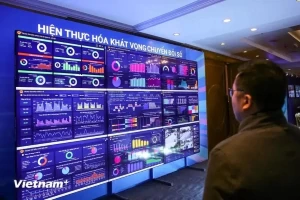
Deputy PM Nguyen Hoa Binh signed decision approving Digital Infrastructure Strategy
Latest
Accordingly, the 5G mobile network coverage is expected for digital infrastructure to reach all cities, provinces, high-tech zones, research and development centers, industrial parks, stations, ports, and international airports by 2025 and 99 per cent of the population by 2030.
 |
| Vietnam will develop various data centers under its digital infrastructure strategy by 2025 with a vision to 2030. (Source: VNA) |
The country aims to operate at least two new international undersea fiber optic cables, form AI Data Centres, and develop new data centers that meet international green standards by 2025 while implementing six new cables and building Hyperscale Data Centres and Digital Hubs by 2030.
Additionally, each citizen will have one Internet of Things (IoT) connection by 2025, and the figure is expected to increase to four connections in the next five years.
The adoption of digital signatures among the Vietnamese adult population is targeted to rise from over 50 per cent to over 70 per cent between 2025 and 2030.
In order to realize the set goals, the country will enhance investment in telecommunications and internet infrastructure, including fiber optic cables, new-generation wifi, and domestic and international transmission systems, ensuring backup demand and purse, as well as secure and sustainable connections.
Besides, due attention will be given to expanding 5G network coverage and service quality, carrying out Internet Protocol Version 6 (Ipv6) for the entire Internet network in the nation, and developing and attracting investments in data infrastructure.
Vietnam will promote the development of physical-digital infrastructure in key areas such as smart transportation, health care, education, factories, agriculture, and tourism to improve the economy’s competitive edge. It will focus on building and promoting interoperability between IoT devices and networks through middleware, capitalizing on the strengths of cloud computing and other advanced technologies to develop industries.
Furthermore, the nation will develop digital platforms to automate socio-economic activities.
















